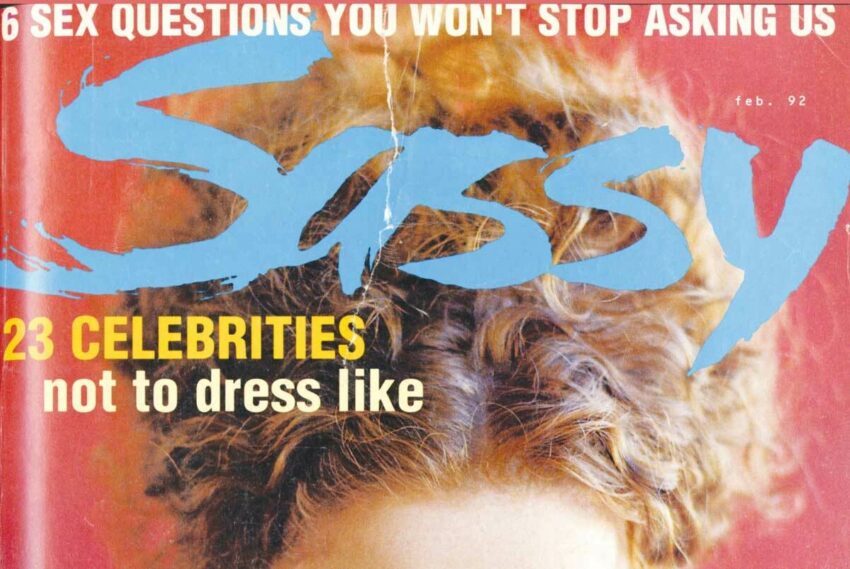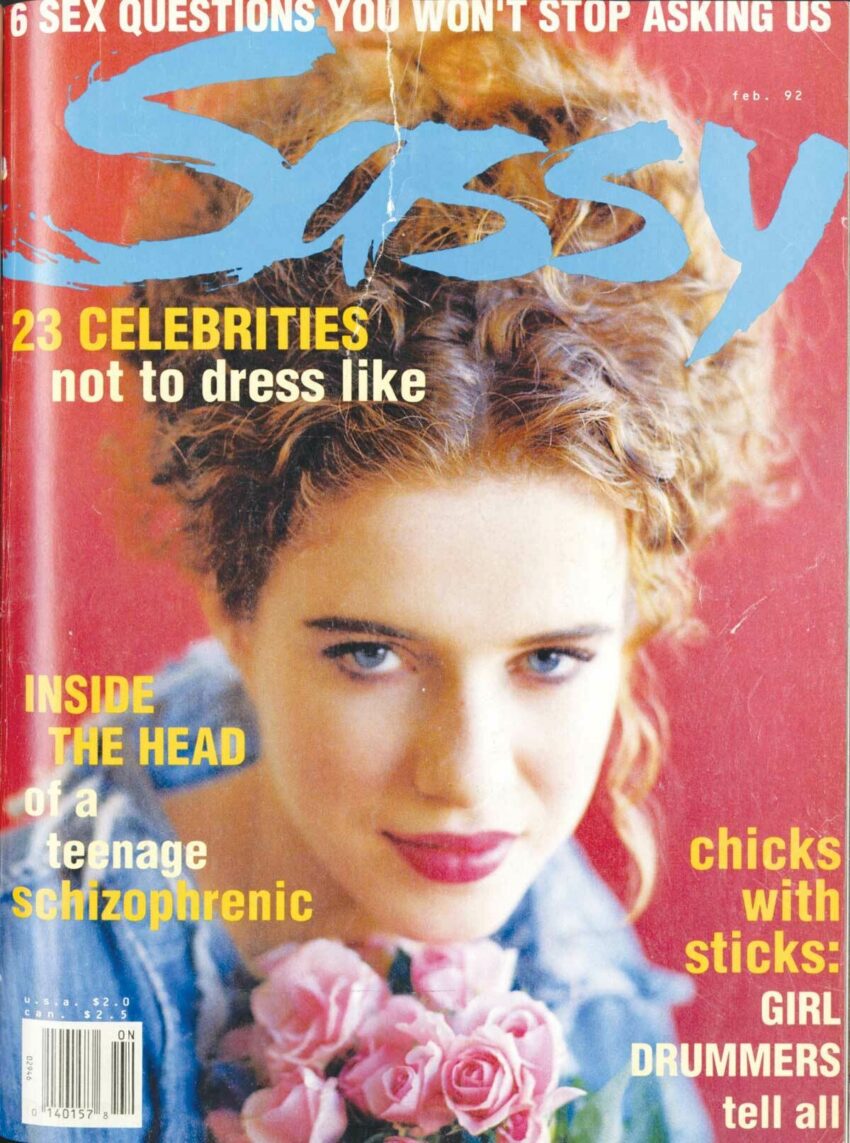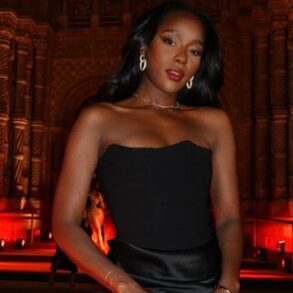How contradiction drove fifty years of feminist media

Detail from Sassy, February 1992. Reproduced under fair use
Nearly all revolutions start with a meeting. When a group of female journalists gathered at Gloria Steinem’s uptown Manhattan apartment in the winter of 1971, they were facing a common problem: none of them could get “real stories about women published.” The male editors of the major women’s magazines—called the “seven sisters,” like the colleges—would not accept pitches that did anything other than advise readers to be better, happier, more productive housewives and mothers. General-interest publications, also edited by men, were no better: according to Steinem, her editor at The New York Times Sunday Magazine rejected all her pitches for political stories, saying “something like, don’t think of you that way.’” Fed up and fired up, the journalists decided to start their own publication. But what kind of publication would they create, and for what kind of reader? Steinem proposed a newsletter, the kind of low-budget, low-circulation flyer that many feminist groups in New York City favored. But the lawyer and activist Brenda Feigen suggested something different: “We should do a slick magazine,” something colorful and glossy that could be sold on newsstands nationwide.
Not everyone was keen on the idea. As Vivian Gornick recalled forty years later, “Radical feminists like me, Ellen Willis, and Jill Johnston…had a different kind of magazine in mind,” one that might argue against the institutions of marriage and motherhood. When it became clear that Steinem and others “wanted a glossy that would appeal to the women who read the Ladies’ Home Journal,” Gornick and her radical sisters bowed out. But others hoped that a glossy magazine might strengthen the feminist movement. Letty Cottin Pogrebin thought a slick magazine could be “a stealth strategy to ‘normalize’ or ‘mainstream’ our message.” As a riposte to The New York Times, which until 1986 refused to refer to a woman by anything other than “Mrs.” or “Miss,” they decided to call their magazine Ms.
The project was ambitious, quixotic, and, historically speaking, unusual. If the newsletter was the preferred form for revolutionary feminist publishing in the late 1960s, the glossy magazine was the form of the prevailing social order. While the radical feminist group Redstockings distributed newsletters and working papers—“mimeographed thunderbolts,” they called them—at its consciousness-raising meetings, Ladies’ Home Journal was publishing a regular advice column—“Can This Marriage Be Saved?”—in which male editors advised unhappy women, some of whom were stuck in abusive relationships, on how to be better wives. (On March 18, 1970, more than a hundred women staged an eleven-hour sit-in at the Ladies’ Home Journal offices, protesting the advice column, the “exploitative” advertisements, the magazine’s all-male editorial team, and the lack of childcare for female staffers.) Newsletters could be made quickly and cheaply and distributed easily; a glossy magazine, by contrast, required infrastructure, employees, and a big budget. More experienced magazine editors warned Steinem and her collaborators against publishing articles about race or lesbianism, suggesting that these “controversial” topics would make it difficult for the magazine to court advertisers and newsstand distributors—both of which were needed to reach a broad audience.
Steinem and her co-founding editors—a group that included Pogrebin, Margaret Sloan-Hunter, and Mary Thom, among others—decided to forge ahead. Ms. launched as a forty-page insert in New York’s December 20, 1971 issue. Its cover image featured a many-armed blue Everywoman—visually inspired by the Hindu goddess Kali—holding an iron, a frying pan, and other household objects. The accompanying article, “The Housewife’s Moment of Truth,” detailed a series of infuriating domestic incidents (e.g., a man stepping over toys rather than picking them up) and helped popularize the feminist term “the click of recognition.” When Ms. published its first standalone issue in Spring 1972, it included Johnnie Tillmon’s essay “Welfare Is a Woman’s Issue”; a piece on lesbian love, “Can Women Love Women?”; and an open letter signed by fifty-three well-known women who had undergone abortions. (Some of these women, including Nora Ephron, later said they had not had abortions but had signed the letter in solidarity.) The issue was daring, provocative, and, in today’s language, intersectional. Many magazine professionals thought it would not have much purchase beyond Manhattan. To their surprise—and to the surprise of the founding editors—the issue sold out in eight days.
Despite its efforts to appeal to all women, Ms. faced its share of criticism from fellow feminists.
Buoyed by this early success, Ms. began to publish monthly, eventually reaching a circulation of 550,000. The magazine published much of its strongest work in the 1970s, when the ambition and reach of the women’s liberation movement was at its high-water mark, stoking broad popular interest in feminism. (Over the course of the decade, feminists went on strike for equality, protested rape, agitated for the passage of the Equal Rights Amendment, and published bestselling books.) In contrast to traditional women’s magazines, which published light, frothy articles on such heady topics as the best way to wash your hair, the general tone of Ms. was serious and occasionally polemical. In 1974, Betty Dodson wrote a “primer on masturbation” that doubled as a celebration of female sexuality. In 1975, Angela Davis examined a legal case in which a Black woman was prosecuted for defending herself against sexual assault. A 1976 piece about the challenges facing lesbian mothers fighting for custody of their children offered a new and important angle on homosexuality, a taboo topic elsewhere in the media world. The occasional satirical piece, like Steinem’s “If Men Could Menstruate,” from 1978, offered much-needed levity.
Ms. was truly the first of its kind: a glossy magazine, sold on newsstands nationwide, made by and for women, and understanding “women’s issues” in the broadest sense. Unapologetically feminist and aimed at a large audience, Ms. reported on abortion, domestic violence, and acquaintance rape long before they were acknowledged, much less debated, in the wider press. The magazine was instrumental in mainstreaming the women’s liberation movement, reaching women who otherwise would have considered feminist a dirty word. It thus represents a key moment in media history: a time when political movements, popular tastes, and market forces converged in such a way that a revolutionary glossy magazine could find success.
But those conditions would not last. As Susan Faludi famously argued, the 1980s saw a media-driven “backlash” against feminism and particularly against women’s ambition. The New Right was ascendant, and it targeted feminist issues—reproductive freedom, affordable childcare—in an effort to bring back what it called “family values.” Those to the left of the political center did not offer much resistance: Weren’t men and women fully equal now? Weren’t those who still identified as feminists making much ado about nothing? Though subscriptions remained steady throughout the decade, Ms. no longer seemed like a magazine with its finger on the culture’s pulse. Less than a decade after its founding, Ms. was struggling to survive.
“If you’d asked me fifty years ago, when we started Ms. magazine, if this first woman-controlled magazine would still be alive half a century later, I would have said absolutely not,” writes Steinem in a foreword to the new anthology 50 Years of Ms.: The Best of the Pathfinding Magazine That Ignited a Revolution. Edited by the magazine’s current executive editor, Katherine Spillar, the anthology, which runs to nearly 550 pages, brings together selected articles, cover images, and letters from readers to show the evolution—and endurance—of the magazine over the last half century. Its tone is celebratory, as well it should be: over the decades, Ms. published journalism and creative writing by Adrienne Rich, Robin Morgan, Sharon Olds, and Alice Walker, among many others. It remains on newsstands today—no small feat now that print publications are more embattled than ever.
Unlike Ladies’ Home Journal and the other magazines it aspired to replace, Ms. did not tell readers how to be women; rather, it expanded their sense of what a woman could be and do. A woman might buy a car or march in favor of the Equal Rights Amendment or refuse to do the dishes. Mothers wrote letters describing how Ms. had made them rethink the division of labor in their households. Girls as young as nine wrote in to say that Ms. inspired them to be their fullest selves. These letters, some of which are collected in 50 Years of Ms., help us understand Ms.’s theory of social change. A woman who picked up Ms. could start making small, incremental shifts in her personal life—and if enough women did so, then maybe society would transform entirely. In this sense, Ms. functioned as a kind of remote consciousness-raising circle: it helped women see that their personal problems were political and that they could live their lives another way.

The longest-running criticisms of Ms. came from Black women, who failed to find themselves in the magazine’s pages. Despite the Ms. team’s efforts, the editors were constrained by their dependence on newsstand distributors. When Alice Walker appeared on the June 1982 cover of Ms., newsstands in the South refused to display the magazine. Image used by permission of Ms. magazine, © 1982.
But since its heyday in the 1970s, the visibility of Ms. has faded. (I confess that before starting this piece, I didn’t realize it was still around.) Since the mid-1980s, from the “backlash” era onward, other feminist magazines, enabled by Ms. but styled in contradistinction to it, drew more attention and attracted different readers. Magazines like Bitch and Bust applied a feminist sensibility
to the traditional material of women’s magazines: beauty, fashion, food, and sex. This focus was both strategic—it is far easier to get advertising money if you are willing to run fashion spreads—and reflective of genuine political commitments. Unlike their mothers, younger generations of feminists were far less suspicious of all things coded as feminine. Many of these magazines attracted devoted readerships, who were crushed when these publications, faced with the challenge of turning a profit while producing feminist content, folded, almost to a one.
The last fifty years of media history have taught us that it is hard to sustain a magazine—and harder still to sustain a feminist one. Time and again, feminist editors, motivated by politics rather than profit margins, confronted the many pressures of the capitalist publishing industry, from the demands of advertisers to the challenges of building a reliable subscriber base. At certain points in feminist history, feminist politics aligned with these industry imperatives. But such periods were usually short-lived: new trends in feminism, culture, and media forced feminist editors to adjust their agendas—or to abandon their projects altogether. The history of feminist magazines shows how, for brief stretches of time, feminists used the publishing industry to spread revolutionary politics. It also raises the question of whether it is worth it for feminists to pursue mainstream publishing success.
feminism has never been a monolith. Even during moments of mass mobilization and peak solidarity, movement leaders had to navigate internal tensions and respond to critiques from within their own ranks. Despite its efforts to appeal to all women, Ms. faced its share of criticism from fellow feminists. Radical feminists thought the magazine was either useless—“I don’t think it did a damn thing for feminism,” said Gornick—or, worse, counterrevolutionary. By portraying feminism in an anodyne and appealing way, the editors of Ms. denatured the movement and alienated their allies, or so the argument went. Members of Redstockings accused Steinem and her team of being “enemies of the movement.” Some even suspected that Ms. was a CIA plot.
the most significant and longest-running criticisms came from Black women, who failed to find themselves in the magazine’s pages. Though the Ms. team was determined to produce content for Black women as well as white women, and though they had Black editors and writers on staff, the editors were constrained by their dependence on newsstand distributors, which were more conservative than the magazine’s readership. When Ms. put Congresswoman Shirley Chisholm, the first Black candidate for president, on its May 1973 cover, almost all newsstands across the country declined to stock it. When Alice Walker appeared on the cover in June 1982, newsstands in the South refused to display the magazine. Walker, who had been a contributing editor for Ms. since 1975, resigned in 1986 in part because the magazine only featured women of color on the cover once or twice a year. (“I do not feel welcome in the world you are projecting,” she wrote in her resignation letter.) On this point, advertisers were even more frustrating than newsstand distributors. In her memoir of the Ms. years, co-founder Thom recalled that “no advertiser could be persuaded that ads featuring black women would work for them,” even though, according to Steinem, “women of color read Ms. in disproportionate numbers.”

If Ms. was for the American housewife-turned-career-woman, then Sassy was for her rebellious teenage daughter, the kind of girl who cared more about unfair labor practices than she did about her prom dress. Sassy, February 1992. Sassy cover reproduced under fair use.
Race was not the only point on which advertisers and editors fought. Clairol pulled its ads after Ms. reported on potential carcinogens in beauty products. In 1980, Revlon refused to place ads after Soviet feminist activists appeared makeup-free on Ms.’s cover. Radical feminists may have found Ms. too cautious, but corporations thought the magazine dangerously revolutionary. As women employees agitated for better working conditions, some corporations, such as American Airlines, refused to advertise with Ms. out of spite.
By the mid-1980s, production and distribution costs were up, while ad money was increasingly hard to come by. Ms. was forced
to run more traditionally feminine ads and more ads in general, cutting poetry and fiction to make space. Steinem later wrote of the fear and “desperation” she felt during this period: “There is hardly a night when I don’t wake up with sweaty palms and pounding heart, scared that we won’t be able to pay the printer or the post office.” In the same essay, which was published in Ms. in 1990, she acknowledged that the magazine’s “edges got smoothed down—in spite of all our resistance.” When she first founded the magazine, Steinem had imagined that a feminist readership with diverse interests and purchasing power would change advertising for the better. Instead, the pressure to please advertisers—publishing’s most concrete proxies for the powers that be—changed the magazine’s content for the worse.
in 1987, two australian feminists, Sandra Yates and Anne Summers, rescued Ms., which had become a nonprofit. While they redesigned Ms. and reinvested in circulation mailings, they also launched a magazine of their own called Sassy, edited by Jane Pratt. If Ms. was for the American housewife-turned-career-woman, then Sassy was for her rebellious teenage daughter, the kind of girl who cared more about unfair labor practices than she did about her prom dress. The typical Sassy reader took many of feminism’s principles and accomplishments as givens. She believed in bodily autonomy, gender equality, and the ability to pursue love and work on her own terms. Yet she also appreciated beauty and pop culture coverage, the kind of “girlie” content that her now-liberated mother might have considered sexist or retrograde. Safe in the post-Title IX, post-Roe, perhaps even postfeminist era, the Sassy reader was free to occupy herself with matters of style.
From the beginning in 1988, Sassy published pieces on serious topics—abortion, sex, STIs—side by side with fluffier features: a regular beauty column called “Zits & Stuff”; profiles of countercultural icons, such as Courtney Love and Kurt Cobain; listicles like “The 20 Males Who Melt Our Butter.” (Such coverage alarmed two Christian mothers from Indiana, who quickly organized a mass letter-writing campaign, encouraging advertisers to boycott the magazine.) Many issues highlighted a “zine of the month,” drawing attention to the niche, low-circulation publications that zeroed in on underground punk bands or the most loathsome characters on the popular show 90210. Sassy differentiated itself from typical teen magazines by refusing to condescend to its young readership while also casting a bemused eye on its peers—a technique that its successors would deploy with great success. For one article, two staff writers tried to follow seduction advice from YM and Cosmopolitan magazines to the letter, with disastrous (and hilarious) results. “I think this was the type of thing I liked best about Sassy,” reads a post from the Instagram account @rewind_sassy_magazine. “They took assumptions about femininity and just blew them up with humor.”
Bust ran articles on how to find “your inner Martha” (as in Stewart, the famed homemaker).
If Sassy and Ms. shared a commitment to feminism and a frustration with conventional women’s media, Sassy approached the topics with a lighter touch. The magazine was funnier than Ms., both more frivolous and more sarcastic. Its tone matched its audience: ironic teens coming of age during the slacker era. It also had a different understanding of the relationship between the women’s movement and the glossy magazine. Sassy did not try to reach naive readers and convert them to feminism; rather, it targeted young women who already identified as “different” and created a media brand just for them. Readers of Sassy describe feeling validated by the magazine: it reassured them that there were other girls out there who shared their beliefs and their tastes. “Sassy aficionados have always been a self-selecting group, people who wanted to establish a chosen community,” write Kara Jesella and Marisa Meltzer in How Sassy Changed My Life: A Love Letter to the Greatest Teen Magazine of All Time. For Yates and Summers and their investors, this community was a reliable subscriber base and a market that advertisers could target. Just a year after the magazine launched, its circulation reached 450,000 annual subscribers, only 100,000 shy of Ms. at its peak. It was also almost making a profit.
Though it brought many like-minded teen girls together, it alienated others. “Am I the only Sassy subscriber who doesn’t dye her hair and/or wear Doc Martens?” one reader asked, in a letter responding to an issue written and edited by Sassy readers. Her question points up the magazine’s presentation of feminism as a mix of political commitments and aesthetic choices. The Sassy reader fumed about censorship and was skeptical of Reagan’s war on drugs—but she was also really into slip dresses, nose rings, and hemming her own pants. Whereas Ms. refrained from making any suggestions about what a feminist looks like, Sassy intimated that a young feminist would have a sense of style. It could thus advertise clothes and beauty products without being accused of hypocrisy, as Ms. was just about every time it placed an ad for lipstick alongside an article about sex-based oppression. Profitable and popular with its young, savvy audience, Sassy had, it seemed, cracked the glossy feminist magazine code.
Sassy lasted only eight years, but other magazines reproduced its formula. In 1993, Debbie Stoller, Laurie Henzel, and Marcelle Karp created Bust, a magazine for “women with something to get off their chests.” In 1995, Andi Zeisler (a former Sassy intern) and Lisa Jervis debuted Bitch, a magazine that sought, as Zeisler later put it, to “integrate feminist thought with the entertainment that had become such a big part of everyone’s lives.” Both magazines started out as homemade zines. Stoller and her colleagues distributed 500 copies of their thirty-page, xeroxed product to independent music stores and bookstores, while Zeisler and Jervis spent four hundred dollars printing their first 300 copies of Bitch. By 2001, both had grown impressively: Bust was now a hundred-page glossy with 35,000 subscribers, while Bitch was a quarterly with 10,000 subscribers. (Other feminist zines, some of which were associated with the Riot Grrrl movement, stayed underground, neither aspiring to mainstream popularity nor attaining it.) Along with Bamboo Girl, for Asian American feminists, and Hip Mama, an alternative parenting magazine, they represented a new era in feminist print culture.
These magazines corresponded to a new “wave” of feminism that emphasized women’s freedom of choice. “There are lots of different ways to be feminist,” Stoller told The New York Times in 2001. If a woman wanted to dye her hair blonde or cook elaborate dinners, those desires were no better or worse than wanting to wear a pantsuit or occupy the C-suite. Indeed, some third-wave feminists thought that the women of the second wave had been too interested in aping traditionally male behaviors, such that feminine-coded interests and activities were unfairly maligned. The feminist magazines of the 1990s published political pieces, but they also affirmed the importance of all things feminine. Bust ran articles on how to find “your inner Martha” (as in Stewart, the famed homemaker). Bitch critiqued the sex advice provided by traditional women’s magazines but also published the occasional article about lip gloss. “Sometimes the girly approach works best,” explained Margarita Alcantara-Tan, the founder of Bamboo Girl. “It’s a lot more approachable to today’s women than the militant in-your-face attitude.”
This approach—call it “choose your choice” feminism, or “let people enjoy things”—matched the cultural atmosphere of the late 1990s. It was the end of history, an economic boom time, an era that was supposedly post-racial and postfeminist. For white, educated Americans, the opportunities seemed endless. Sexism still existed—witness the Clarence Thomas nomination hearings in 1991—but many young women who benefited from the battles feminists fought and won in the 1970s did not think it would shape their lives. In their 2000 book Manifesta: Young Women, Feminism, and the Future, Jennifer Baumgardner and Amy Richards wrote, “While on a personal level feminism is everywhere, like fluoride, on a political level the movement is more like nitrogen: ubiquitous and inert.” The new feminist magazines thus faced a challenge: they needed to reassert the importance of feminism without appearing to be overly dramatic or out of touch. “I know that celebrating nail polish is not going to save a woman’s right to abortion,” Stoller told The New York Times. “But I also don’t think we have to go and point out every single wrong in society.”
Ms., meanwhile, remained committed to pointing out those wrongs. During the 1990s, the magazine published articles on femicide, sexism in rap, and the traumatic birth experiences of Native American women. That the magazine was publishing at all was a coup. Ms. had nearly gone under in 1989, when it was sold to a new parent company, one that planned to reduce the production value and frequency of the publication. Some thought Ms. would reemerge as a black-and-white newsletter—Steinem’s original vision—but when 60,000 copies of the July/August issue appeared in the late spring of 1990, the magazine was still a magazine: one hundred pages, colorful, and, crucially, ad-free. “They said it couldn’t happen,” crowed Robin Morgan in her introduction to the issue. “They said readers wouldn’t want a major feminist magazine of substance, audacity, quality. They said this is a ‘postfeminist’ era.…Well, welcome to liberated territory.” Readers rejoiced at the magazine’s newfound editorial freedom, even if the absence of ads meant a higher price per issue.
At the turn of the twenty-first century, then, two generations of feminist magazines—and two generations of feminists—coexisted, if somewhat uneasily. Ms., now with a more limited production run, continued to cater to an audience that cared deeply about the oppression of women along different, intersecting axes. Bust and its ilk appealed to a growing market of young, girly feminists who did not want to read a magazine that was, to use nineties terminology, too harsh. As Bust’s circulation grew to 100,000 subscribers, it began attracting the interest of major media companies. Feminists of the Ms. generation looked on skeptically. “Once they get big, they will become indebted to their advertisers and they will not be able to write about just anything,” warned Erica Jong. “Women’s magazines tend to be indebted to the corporations that advertise in them.”
when jong issued her warning in 2001, she could not have foreseen the way the internet would change magazine publishing and, with it, the relationship among readers, editors, and advertisers. Editors in the early 2000s could track how different articles performed with readers as well as get a sense of who their readers were. Where Steinem, in 1970, had struggled to convince editors that women read articles about politics and world issues, editors of general-interest magazines could now see that women readers were a force to be reckoned with. The nature of media advertising also changed dramatically. While print ads had set prices based on the size of the ad and circulation of the magazine, digital advertisements, which were generally less lucrative, paid out based on the number of times an ad—and the article attached to it—was viewed. These two changes to the publishing industry encouraged editors to think carefully about how each individual article a magazine published would perform online.
These conditions led to the rise of a new kind of feminist magazine: the blog. Blogs tended to be intimate and chatty, and they often published daily, if not multiple times a day. Blogging lent itself well to commentary as opposed to reporting, which required more time and resources. Gossip sites in the vein of Gawker, launched by Nick Denton in 2002, first took blogging corporate, but soon there were political blogs, food blogs, mommy blogs— and feminist blogs.
In 2004, Jessica Valenti founded Feministing, an independent blog that covered everything from “slut shaming” (a term it helped popularize) to sex advice. Prompted in part by the sexist coverage Hillary Clinton received during her first presidential run, Slate launched The XX Factor in 2007 (two years later, it became the standalone website Double X). These new publications offered a blend of Ms.’s seriousness of purpose and Bust’s pop-cultural sensibilities. Feministing, for instance, covered online misogyny in the form of Gamergate, but it also interviewed celebrities and ran a feature called “Hot Menses Mess.” While Bust tried to draw readers in with articles about beauty and then remind them that gender equality had not been fully won, Feministing and its counterparts were direct about their feminist politics. This approach proved successful: in 2009, The XX Factor drew a million unique visitors a month, while Feministing, at its peak, attracted 1.2 million unique visitors. All those clicks were not always enough to sustain a magazine—Feministing relied on donations as well—but they still indicated that an unapologetically feminist approach could bring significant traffic.
In 2007, Gawker Media capitalized on this trend by launching its own feminist blog, Jezebel, with the tagline “Celebrity, sex, fashion. Without airbrushing.” Its editor, Anna Holmes, had come to Gawker Media from the traditional women’s magazine InStyle. Rather than going after individual women, as the main Gawker site often did, Holmes went after women’s media. Jezebel ran a feature called “Cover Lies,” which mocked the photoshopped cover images of women’s magazines. It paired such snarky coverage with sex advice from a psychologist and cannabis enthusiast (“Pot Psychology”) and no-holds-barred women’s health stories, such as Moe Tkacik’s “Ten Days in the Life of a Tampon.” Holmes did not worry about alienating advertisers; her boss, Denton, cared more about engagement, and Gawker Media’s brand of irreverence had proved appealing to readers. With its breakneck production schedule—a new blog post appeared roughly every fifteen minutes—Jezebel would keep readers on the site and deliver the high page view numbers that advertisers now required. A year after launching, with its successful mix of snark, feminism, and pop culture coverage, Jezebel attracted just under 360,000 unique visitors each month, a number that spiked to 500,000 after the website was mentioned on the official blog of the TV show Gossip Girl.
Compared to its fellow feminist blogs, Jezebel’s tone was edgier, even cruel. The content often seemed designed to outrage readers, though not necessarily to mobilize them. While many websites and blogs had comments sections, the commenters at Jezebel were especially active. They argued with each other, befriended each other, and established social hierarchies, as if Jezebel were a high school cafeteria. “I feel like Jezebel is a club more than a blog,” one reader/commenter told The New York Times in 2008. “Jezebelles” or “Jezzies,” as some commenters called themselves, met up in real life for drinks and weekend getaways.
But the comments section could also be a dangerous place. Across digital media, commenters often saw themselves as stewards of their favorite sites; this was especially true of Jezebel, where commenters who identified as feminists might criticize a writer, not always nicely, for an article that they thought took the wrong angle on an issue or was insufficiently feminist. (Several controversies erupted around the writer and director Lena Dunham.) Just as the internet undid the traditional relationship between advertisers and magazines, Jezebel and its active commenters complicated the relationship between editors and readers. Who got to say what the feminist perspective was, the women running the magazine or the women reading it? “Jezebel commenters are really hard on writers,” remarked Emma Carmichael, who took over as editor in 2014. Writers started to self-censor, to work apologies and caveats into their posts. Carmichael hoped that writers would eventually feel free to say whatever they wanted, even if it did not go over well with the commentariat. “Online feminism has more and more rules lately,” she said on the Longform podcast a few months after taking the position at Jezebel. “The ideal with Jezebel is getting to a point where you can say, ‘This might not go over as well…but it’s what I think, so who gives a fuck?’”
Forty years ago, feminists of the Ms. generation had asked many of the same questions that now preoccupy twenty-first-century feminists.
Jezebel, along with other feminist blogs, paved the way for several websites that emerged during the 2010s, including The Frisky, The Toast, and The Hairpin, where Carmichael got her start. Each of these websites catered to a different stripe of young urbane feminist, though there was certainly overlap among the audiences. Each applied a feminist sensibility to cultural material: The Toast posted humorous interpretations of classic literature and art, while The Hairpin combined mockery of women’s media—founder Edith Zimmerman’s iconic meme “Women Laughing Alone with Salad” comes to mind—with thoughtful, quirky features on sex, beauty, and celebrity. Anne Helen Petersen’s popular series “Scandals of Classic Hollywood” offered a cerebral take on celebrity gossip, suggesting that one could be sophisticated, intelligent, and deeply invested in Warren Beatty’s dating history all at the same time.
This vibrant feminist media ecosystem was sustained by a broader resurgence of feminism in the United States across the 2010s. Feminism was once again popular, profitable, and politically necessary. The 2016 election and its horrifying aftermath elicited a range of feminist responses, from the record-breaking Women’s March to Jessa Crispin’s 2017 manifesto, Why I Am Not a Feminist. The so-called #MeToo movement, which gained steam in late 2017, brought workplace harassment and sexual misconduct into the national spotlight. By the end of the decade, feminism was vibrant and hotly contested, as women debated—in conversation, in print, and online—who feminism was for (white women? rich women? all women?) and what it required a woman to be or to do.
In this context, one might have imagined that Ms., the original feminist magazine, could reemerge from the shadows. And, based on the pieces included in 50 Years of Ms., it seems that the magazine did try to stay relevant. Articles on the 2014 Isla Vista murders and the women of Black Lives Matter demonstrate the magazine’s responsiveness to current events as well as its ongoing commitment to intersectionality, a concept that gained more mainstream traction in the 2010s. The magazine also increased its pop culture coverage. One anthology selection from 2013 celebrates “Beyoncé’s fierce feminism,” while another explores the messages of the 2017 summer blockbuster Wonder Woman. (The latter hearkens back to an earlier Ms. analysis of Wonder Woman published in 1972, which is also included in the anthology.)
But due to a confluence of factors—from its quarterly production schedule to its aging stable of writers—Ms. has not regained the prominence it had during its first decade. It is tempting to narrate this failure teleologically: a generation of inferior feminists was surpassed by a generation of superior ones. (For a time during the 2010s, “second-wave feminist,” often mistakenly conflated with “white feminist,” was used as an insult.) But history is cyclical. The same conflicts and debates that divide a social movement during one phase of its existence often reappear later, in slightly different form. There is a reason Ms. published a throwback cover that resembled the illustration for “The Housewife’s Dilemma” during the height of the COVID-19 pandemic. Forty years ago, feminists of the Ms. generation had asked many of the same questions that now preoccupy twenty-first-century feminists: How does sex-based oppression interact with class-based oppression? Why is motherhood so difficult in the United States? Can heterosexuality be redeemed? If readers did not pick up Ms. to get the answers to such questions, that might have been because they could easily find them elsewhere. In this sense, Ms. was not a failure but a victim of its own success.
This post was originally published on this site be sure to check out more of their content.








